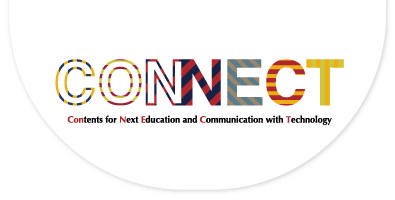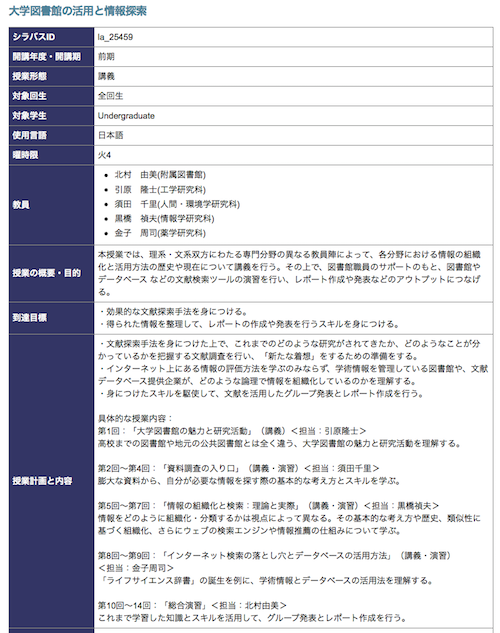TopicsTeacher Interview
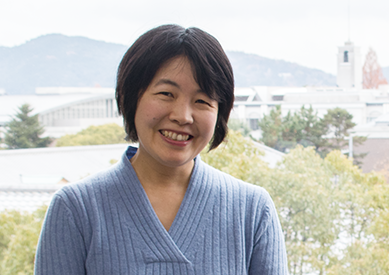
Hands-On Practice at the Library That Empowers Students to "Step Forward"
Associate Professor Yumi Kitamura, Kyoto University Library
From Online Public Access Catalogue (OPAC), online journals, e-books, institutional repositories, to "My Account" features - with advances in information technology, university libraries nowadays provide a broad array of ICT-based resources and services. Along with diversifying ICT applications, the users should also optimize their literacy to take full advantage of such rich and useful information resources.
In this exclusive interview, Dr. Kitamura of Kyoto University Library shares her continued efforts toward designing "Academic Information Literacy" courses, mainly for freshman students. Dr. Kitamura aims to train her students on how to take an input and then to convert it into an output. She designs her course outlines in collaboration with professors of other departments and Kyoto University librarians. Dr. Kitamura talks about what she expects Kyoto University students to experience, and learn from her courses.
- PROFILE
- After completing her Master's degree in Library and Information Sciences from the University of Hawaii, Dr. Kitamura was appointed Assistant Professor at the Center for Southeast Asian Studies, Kyoto University. In 2009 she received her Doctor of Philosophy in language and society from the Hitotsubashi University. From July 2012 to present, Associate Professor of Kyoto University Library.
She received an award from the Japanese Society for the Studies of Chinese Overseas in 2015, in recognition of her book Re-creating Culture of Chinese Indonesians in the Post-Suharto Era (Akashi Shoten, 2014), a modified version of her doctoral thesis.
She plays a pivotal role in leading a start-up project to set up Learning Commons at Kyoto University Library, as well as a collaboration project that integrates Southeast Asian studies with library and information sciences.
In her spare time, Dr. Kitamura enjoys resting at home, dining out, reading books, swimming, and traveling.
Facilitating Students' Transition from "Study" to "Research"
Could you briefly introduce your "University Library Data Searching" course?
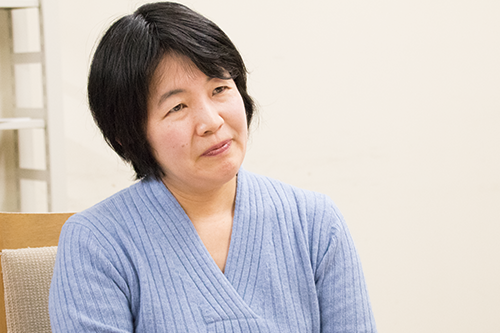
Sure. The "University Library Data Searching" course is offered in the first semester, and is open to all majors. A total of five lecturers, including myself, take turns to teach classes.
In the first class, Dr. Takashi Hikihara*1, Director and Dean of Library Network, lectures on how learning environments in high school are different from those of university, touching on recent trends such as open access. From the second class on, each of the four lecturers is assigned to teach 2~5 classes
*1 Since academic year 2018 Dr. Hiroyuki Matsui (Professor at Graduate School of Management Administrative Office/Vice Director of Kyoto University Library Network) has been in charge of the first lecture.
Aside from me, the three lecturers are researchers of different expertise, including literature, information sciences, and pharmaceutical sciences. Each one of them talks about their own research process and methodologies, while underscoring the necessity of generating ideas and organizing information to carry out research. The key agenda of their talks is to convey the students "the essence of research" that is common across research disciplines.
Each lecture finishes with a practice session, which Kyoto University librarians join as teaching assistants.
Is the course open to all students?
Yes, it is open to students of any majors, but basically, the class is geared toward freshman students. Our goal is to facilitate fresh high school graduates to shift their learning paradigm from routine high school study to research-based university study at the onset of their university life.
Since when has the course been offered?
The very first course was offered in 1998, so it's been almost 20 years now. Dr. Makoto Nagao, who was then Director of Kyoto University Library, took an initiative in 1995, and started offering the first prototype of the course right after he took up the post of President of Kyoto University in 1997. The original title of the course was "Introduction to Information Retrieval," and the course has continued to this date with minor changes made to the course title several times.
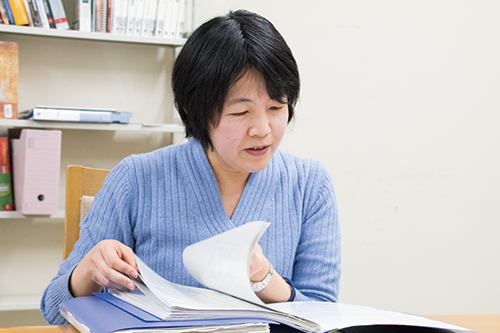
Dr. Kitamura flipping through archives during her interview. She noted that university libraries and librarians have seen a sea change in their expected roles in the past quarter-century.
Back then, there was a growing trend towards digitalization of university library resources, which made the world of academic information more complex and diverse.
Amid the movement, Kyoto University Library took a lead in crafting a course that focused on improving students' skill sets for searching and collecting information and optimizing the search results for their best use. With this concept in mind, we designed our course.
You mentioned earlier that librarians also participate in the course?
Yes, they do. This is part of the SD (Staff Development: institutional efforts to help administrative staff members improve their skills and performance) for early career librarians. We assign our librarians to talk in front of the students occasionally, as well as providing technical assistance to the students.
Imagining that each one of our librarians assists different classes, I would say the annual total number of librarians participating in the course should be so large. This tradition has been followed since Dr. Nagao's era, hinting that libraries and librarians are called to take on more educational roles than ever before.
During the past 20 years, the course must have changed a lot, right?
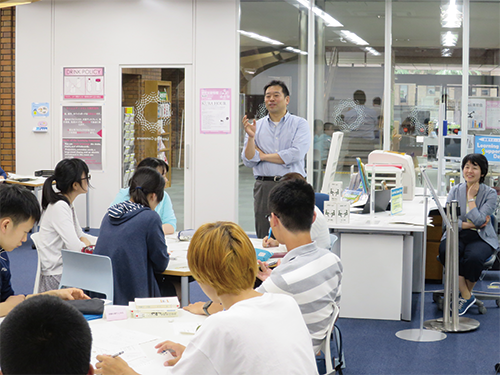
A scene from a "practice" session of the "University Library Data Searching" course. This unit was lectured by Dr. Kurohashi of Graduate School of Informatics (image provided by Library Network).
It sure has changed a lot, including lecturers, librarians, and course objectives that have been revised several times. Lecture contents have also been adjusted to reflect these changes.
5 years ago when I first taught this course, 13 sessions from the second week's class were divided into five units and each unit consisted of two parts: a lecture part and an exercise part. Nowadays, the last 5 class meetings are themed on "comprehensive practice," allocating enough time for the students to engage in discussion and making presentations. This practice ensures that students have opportunities to produce output by the end of the course.
One of the key changes from the previous year to this year is the introduction of a flipped classroom approach to our course.
You have adopted a flipped classroom approach. Could you talk about how it all started?
At the end of each semester, all lecturers and librarians are called to a review meeting to exchange fresh feedback and ideas for the coming semester. That's where Dr. Kaneko of Graduate School of Pharmaceutical Sciences suggested that a flipped classroom approach might work synergistically with our course, so we gave it a try this year.
We have interviewed with Dr. Kaneko*2 before. So all the lecturers and librarians get together all at once and have a review meeting? Quite impressive.
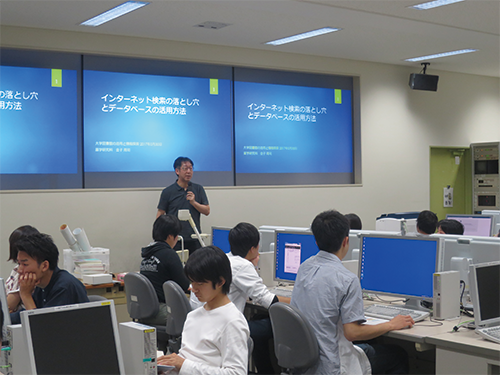
Dr. Kaneko teaching one of the "University Library Data Searching" classes (image provided by Library Network).
Dr. Kaneko has been on board since the first year of "Introduction to Information Retrieval" and he has been so helpful in giving empirical advice on how to improve our course.
The review meeting is normally attended by around 20 people. They each bring in some data and survey results from their classes, exchange information, and discuss the course directions for the coming year. In the meeting held after the last academic year, we carefully examined which part of the course content could be flipped along with the transition to a flipped classroom.
*2 The interview with Dr. Kaneko of Graduate School of Pharmaceutical Sciences can be viewed through the following link.
Related Article: "Flipped Classroom: Respecting Individual Learning Needs" (released on April 25, 2018)
Which part of the course contents did you find were successfully incorporated into the flipped classroom model?
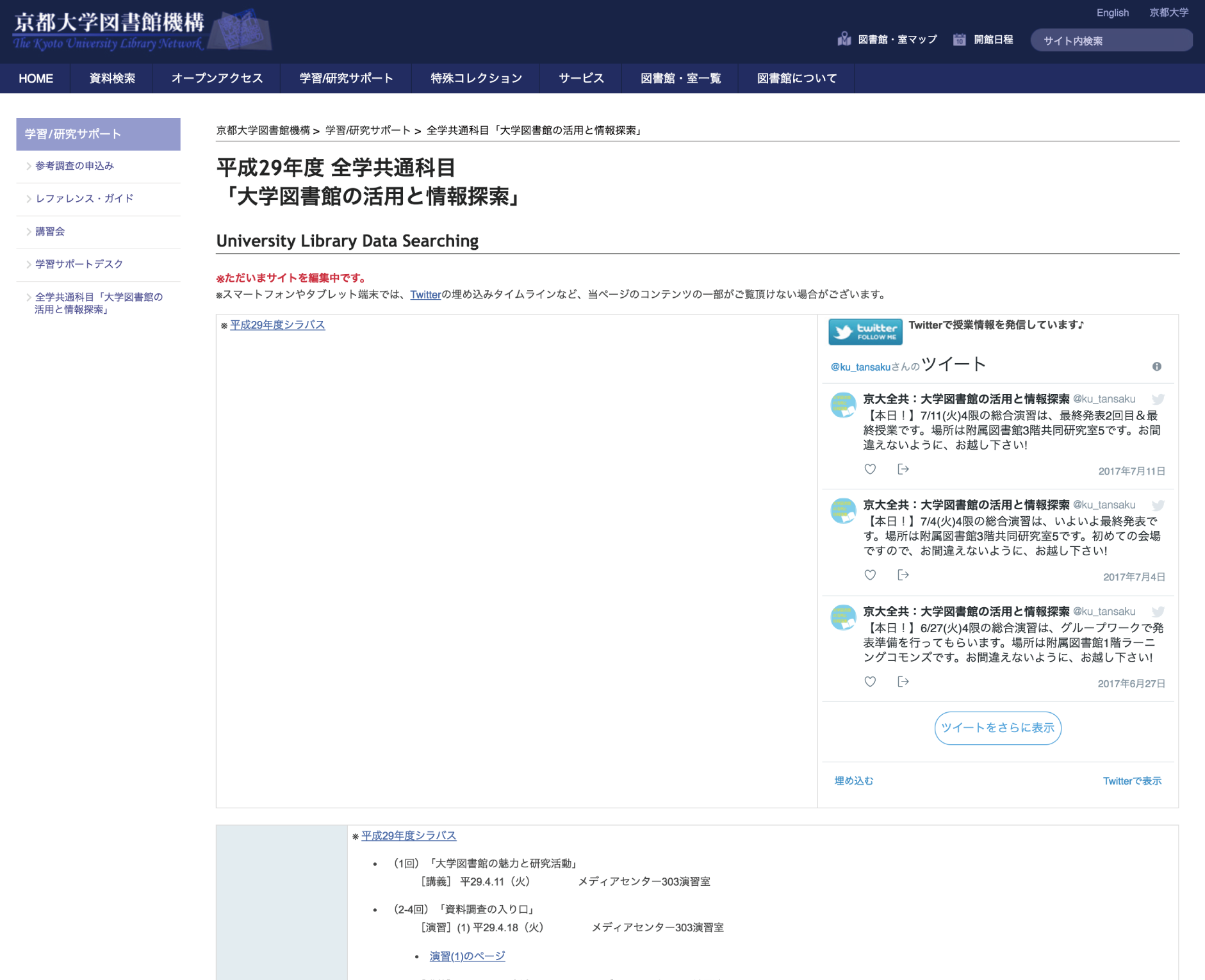
Website of Liberal Arts and General Education Course "University Library Data Searching" (click the image to open the website [only in Japanese]).
Twitter has also been actively used for communication purposes.
One particular example is supplemental handouts. Generally, librarians are good at preparing handouts as their profession requires them to do so, and conversely, they end up giving commentary on their handouts in class, taking up their lecture time and leaving less time on the practice session. From this year on, the course has started requiring students to check those handouts prior to the class time, allocating more time for in-class practice and discussion.
Other than handouts, did you also make video clips as preparatory learning materials?
Yes, we did. We had each of our lecturers shoot a shorter version of their lecture, put a narration to their recordings, and uploaded the videos on YouTube. The videos and other materials are made available on the course website.
As for storage of the materials, we are in the process of compiling all of our course materials on PandA*3. Since its operation started, we tested the usability of the platform, and since last year, all of our course staff started to upload their materials on PandA.
As our course is run by a large number of staff members, classroom environments and teaching strategies may differ. All the more so, PandA is conveniently used as a solution to unify the course contents.
*3 PandA is the online LMS (Learning Management System) provided by Institute for Information Management and Communication, accessible to Kyoto University students and staff.
Observing the way you talk, apparently, you have taken an enormous time and so much care into your course. Since it broadly covers essential topics such as searching and managing information, it would be ideal if all freshman students could take the course and equally learn the essentials. Is it something like a feasible idea?
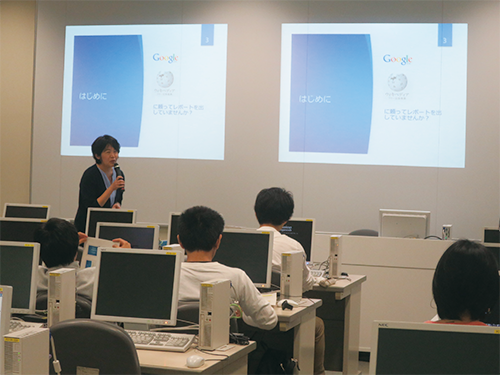
Dr. Kitamura's lecture in Liberal Arts and General Education course "Practice of Basic Informatics" (image provided by Library Network).
Well, since the course includes group activities and presentations, 40-50 students at most would be an appropriate number of students per class. There are about 3,000 students entering the university every year so....
Not necessarily as an alternative option, but in a Liberal Arts and General Education course entitled "Practice of Basic Informatics," I am in charge of teaching one unit focusing on the essentials of the practical use of library resources. There are 5 of these classes open per semester, so at least, some hundreds of students have the chance to learn about the topic every year.
Starting next year, a new graduate-level Liberal Arts and General Education course "Basics of Academic Information Literacy" will open. There as well, I will be invited to talk about the topic.
In the case of graduate schools, quite a few students are graduates of other universities, so the newly introduced literacy education course should be well received.
Indeed. On top of that, there're always orientations and workshops going on all year round at Kyoto University Library and library rooms of other departments*4. All are welcome to attend these events.
*4 Please see the following article on the orientations and workshops held at Kyoto University Library.
Related Article: "Library Network's Efforts on Supporting Students' Individual Learning Needs" (released on March 19, 2019)
These services are beneficial for us, faculty members, as well. It makes a significant difference to the progress and achievement of classes if students have been trained in information literacy and retrieval.
Importance of Concept Classification and Analysis with the Growing Popularity of Keyword Search
Have you seen any particular changes in students' literacy?
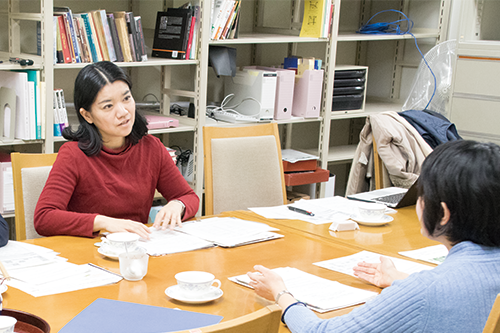
In recent years, students tend to do a Google-inspired keyword search even when they are doing a literature search with online journals, leaving them to be solely dependent on information search on a hit-or-miss basis.
What has traditionally been done was that we started with selecting an academic discipline, then narrowed down the search according to the field of interest, and finally picked up some relevant articles and information. What happens with a keyword search is that we jump straight to the results pinpointing some articles and information. There are some terms that are used in different definitions or ways depending on the field of study, but regardless of those differences, results from a keyword search will be displayed in parallel only because they match the search keywords.
Researchers have the knowledge to interpret that some terms are defined differently in other fields and that the definitions do not apply to their own field, and such, but freshman students do not have enough background knowledge to do so.
I see your point. Keyword search results include both irrelevant and relevant information at the same time.
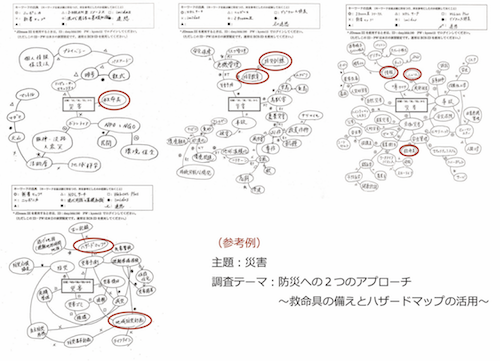
Sample keyword maps generated by course staff (click to enlarge the image). During group practice sessions, each student builds a keyword map, compare it with the group members, and discuss a potential topic for their presentation (image provided by Library Network).
That's right. Search rankings are solely dependent on the algorithms of the search engines used. To save students from getting lost in random search results, the "University Library Data Searching" course clarifies the definitions of superordinate and subordinate concepts first. Paying attention to the two concepts, students then do some practice with keyword searches on KULINE (Kyoto University's OPA), and build a "keyword map."
"Superordinate concept" and "subordinate concept"?
Right. Let's take iPS cells as an example. Its superordinate concept is regenerative medicine, and the subordinate concept is more specific objects and events, such as names of cell sheets. If students do some keyword search and end up having either an overwhelming amount of results or too few results, the keywords or their concept levels should be reconsidered to obtain more relevant results in most cases. The most common issue that students encounter while practicing keyword searches is the volume of search results being either too high or too low.
That's an interesting point. Since searching itself can be done so easily, students should be guided through more structured and appropriate approaches to searching.
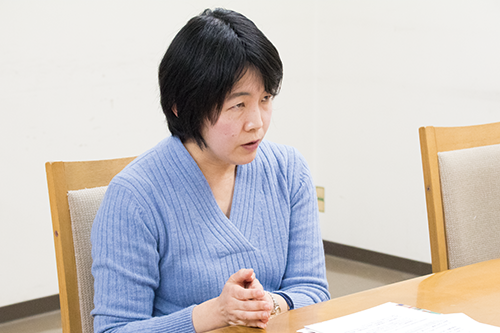
Exactly. Superordinate and subordinate concepts are to classify objects into two levels. Come to think of libraries. They are there to classify information into different levels, also to reconstruct the world by filtering some information.
I am not talking about just libraries. Academics are classified into disciplines, and all the more because they are classified, the term "interdisciplinary" makes sense.
Empowering Students to "Step Forward" through Hands-On Practice
Since you started teaching the course, have you seen what Kyoto University students generally excel at, and in what areas they should improve?
Certainly. I teach several courses in other universities. Kyoto University students, if compared with students from other universities, have the courage to tackle these tasks that are highly intellectual and challenging. Kyoto University students tend to show more interest in my talks if I speak in a professional tone, rather than using a plain language. By the same token, Kyoto University students wouldn't let themselves admit that they don't understand some parts of my lectures and ask questions in class; they would rather review by themselves later on, till they fully understand what they have missed in class. I really admire that Kyoto University students have this "stamina" for learning.
On the flip side, it is obvious that Kyoto University students are afraid of not having "right" answers, which is their major weak point. Students of some universities I know are less anxious about making false answers, and they don't hesitate to ask questions in class probably because their threshold for asking questions would be low. This learning environment invites impromptu discussions and follow-ups in class, which boosts students' overall understanding in the end.
When it comes to Kyoto University students, they are excessively shy about making false answers in front of others, which limits their chance of asking questions about something they don't understand.
University-level study is intended to teach the subjects that have no definite answers, and university students are supposed to train themselves in searching for solutions to the problems where there is no right or wrong answer. Yet, Kyoto University students end up being afraid of not having a right answer.
Don't they propose some potential "right answers" that they think may impress teachers?

Dr. Kitamura sharing her teaching philosophy: she tries to facilitate her students to feel the joy of not only logical but physical learning experiences.
They really do, but that's not a good training for them. I often tell my students "There are millions of things that I don't know, so I want to invite all of you to join me in searching for possibilities." It won't work effectively to Kyoto University students, as changing their learning styles is not an easy task.
As I myself go on fieldworks for my research, it made me realize that we can spend ample time for idea searching while doing physical activities. This must apply to Kyoto University students, but they have a tendency to think only logically, but not physically.
I see what you mean by that.
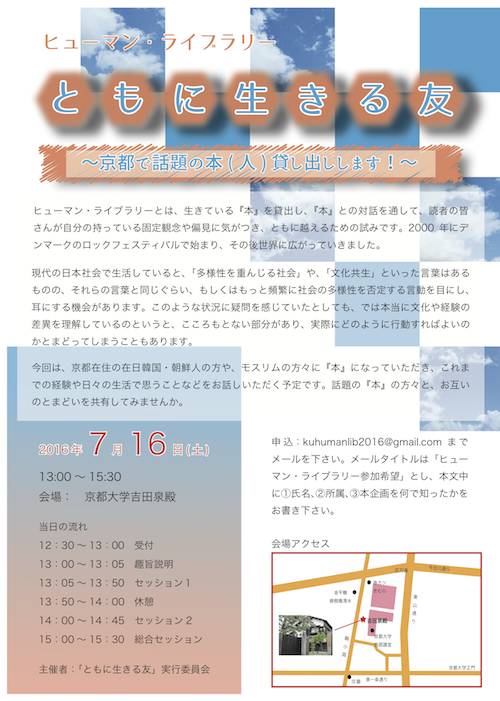
Flyer of the Human Library event series, designed by students from "Advanced Studies on Library and Information Studies I" (image provided by Dr. Kitamura)
So I design my course with a clear vision that my students could eventually get their feet moving forward by experiencing a variety of learning activities.
As a practical example, aside from the "University Library Data Searching" course, I teach "Advanced Studies on Library and Information Studies I" at the Faculty of Education. I ask my students to manage and run the "Human Library"*5 event series.
Students of this course take the initiative in deciding on a theme of "books" to showcase, and take full responsibility for building a trusting relationship with people who will be speaking as "books" and event scheduling. I leave everything up to my students.
*5 An international project originated in Denmark. In the event series, readers "borrow" books, which are people with special experiences, such as those who are physically challenged and of minority groups. The event aims to dilute people's stereotypes and prejudices through dialogue and mutual understanding. Also called the "Living Library." For further details, please visit the following link: The Human Library Organization website.。
Some students grow dramatically through the process. There's a lot to see and feel, so please come and check out the event. Honestly, many of my students at first have a hard time joining in group discussions and setting up meetings, but gradually, they get used to coordinating with others.
This is linked to what I said earlier: there is no right or wrong answer, so just take the courage to step forward. As my students take full responsibilities with planning and organizing the event, this experience leaves them ever so vivid and impressive memories.
Are there any comments from your students that are deeply imprinted in your heart?
Yes. This is from the year when group activities were first introduced to my "University Library Data Searching" course. There were two male fourth-year students who were taking the course very seriously, while most of their classmates were freshman students.
At the very end of the course, the two students came to me commenting that they learned a lot from the course. I was curious to know what it was that they, who were soon to graduate and already got a job offer, learned from my course. One of them opened his mouth and started telling me that he had long felt something uncomfortable and left alone, being surrounded by glass walls. He then realized that the glass walls disappeared by taking the course.
Their comments came as a surprise to me. Both of the fourth-year students were active in club activities and they had high social skills. While they were in class, they joined group activities trying to remain reserved rather than being bossy, and treated their freshman classmates with respects. By doing so, they could naturally shorten the emotional distance between themselves and their classmates.
Don't you feel rewarded especially when you see your students change over the course?
I sure do. The students I just mentioned were already in their final year in university, but while taking my course, they went through fresh learning experiences by thinking with physical senses and communicating with others to exchange ideas.
I do hope that students go through such mind-blowing learning experiences, and to make it happen, my responsibility is to empower them to take a positive step forward.
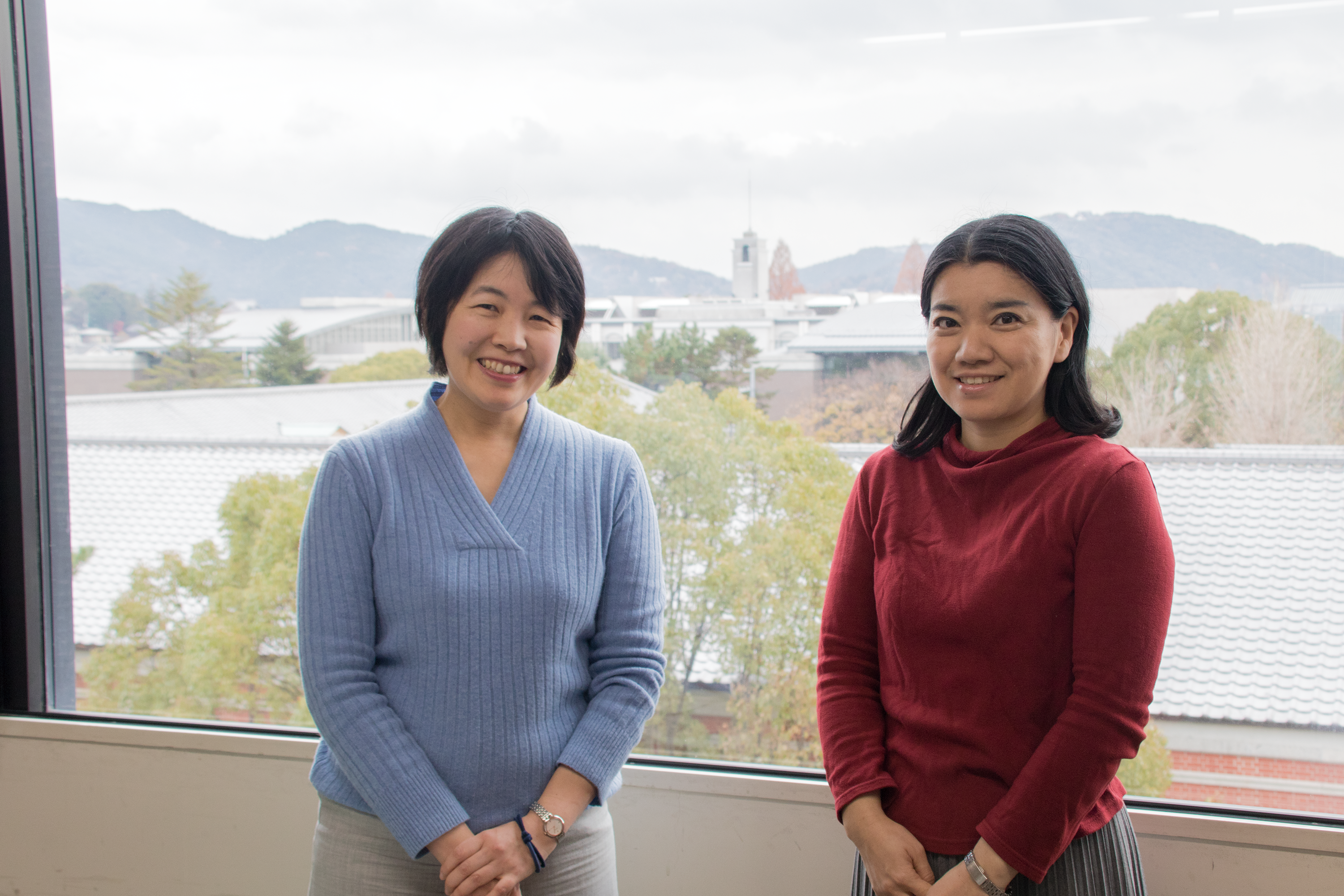
Dr. Kitamura and Associate Professor Taguchi of Center for the Promotion of Excellence in Higher Education, who interviewed Dr. Kitamura.
The Higashiyama area lies in front of Dr. Kitamura's office. The buildings right behind the doctors belong to Yoshida Minami Campus, where freshman students take Liberal Arts and General Education courses extensively.
Editor's Note
Dr. Kitamura's words: never be afraid of having no right "answers"; turn to your "logical" and "physical" voices, touched my heart as they reminded me of my university days. I highly recommend that current students take her course and learn valuable lessons.
Incidentally, what inspired Dr. Kitamura to study at the University of Hawaii was a book she found at a bookstore titled "Guide to Careers in International Organizations."
In the book, there was a passage saying that having a degree in library science would be an easy path to work at the United Nations. Convinced by the book, she decided to study at the University of Hawaii where she could do both area study and library science studies at the same time.
Observing how gently she talked with a smile, I could hardly believe she had such an adventurous spirit in her. At the same time, I was convinced that her own real-life experience had a profound influence on her current teaching style.
Related Articles:
・ "Flipped Classroom: Respecting Individual Learning Styles" (released on April 25, 2018)
・"Library Network's Efforts on Supporting Students' Individual Learning Needs" (released on March 19, 2019)
Questions asked by: Mana Taguchi
Article composition: Takeo Suzuki
Photography: Wataru Kono
Interview date: December 8, 2017
Published online: March 12, 2018 (Original article)
March 19, 2019 (English article)
